Buenos Aires' Colectivos, how-to step-by-step guide
Hello Steemiter (or Steemiar?)! Welcome to my first post!
Have you ever wanted to travel to Buenos Aires but you were afraid of getting lost in the labyrinth of buses/colectivos lines? Well, probably not, because nobody thinks about that.
Anyway, I'm going to tell you, step by step, how to travel in one of those like a PRO, in a very clear way that even a person who have never used a public transport will understand:
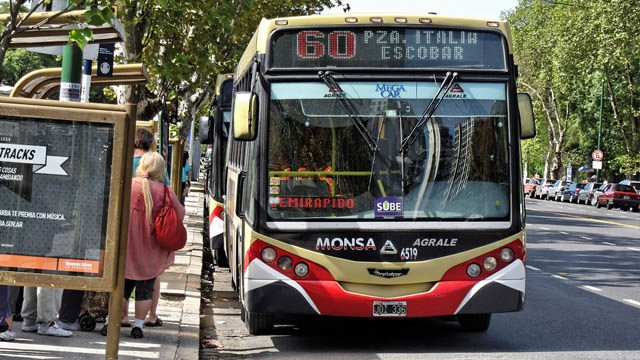
A colectivo
Table of contents
City of Buenos Aires
Prepare your tools
Step 1: Understanding the transport’s card “SUBE”
Step 2: Getting the “SUBE”
Step 3: Getting out the airport of Buenos Aires
Step 4: The hotel address
Step 5: The apps tells you which colectivo you need
Step 6: Waiting for the Colectivo
Step 7: Stopping the colectivo and paying for it
Step 8: Jumping on board
Step 9: “Inside the colectivo” Etiquette
Last Step: Getting out the colectivo
Bonus: spanish/english phrases

City of Buenos Aires
The City of Buenos Aires is the capital of Argentina. 3 millions of "porteños" (people "from the port") lives in an metropolitan area of 203 km2 (78.5 sq mi), the place for tango, great meals, french architecture, beautiful women and charismatic men (and also charismatic women and beautiful men, why not).
The colectivo (means "collective") is a bus, and it is the main public transport of the city. There are hundred of different lines, with different numbers and colors to identify them, and together they cover the entire city by a very low fees (0.35 to 0.39 US dollars per person per travel).
The city also has an underground service that we call "Subte" (short of "subterranean"), and taxi cabs, but today we are only taking about colectivos.
Prepare your tools
You will need these:
A SUBE card, the card used to pay for the transport. It can be bought in many places, as described in the official website: https://tarjetasube.sube.gob.ar/SubeWeb/WebForms/admin/views/mapa-sube.aspx?id=1
https://mapa.buenosaires.gob.ar/ is an official website of the goverment to help you move around in the city, by bicycle, car or bus.
"BA Cómo Llego" (means "Buenos Aires, How do I arrive?") is the official smartphone app of the goverment, you can get it here:
Android: https://play.google.com/store/apps/details?id=ar.gob.buenosaires.comollego
iOS: https://itunes.apple.com/ar/app/ba-como-llego/id576489186If you have a maps app (ex. Google Maps), I fully recommend to download the map of the city for offline reading. 4G in Argentina may be not compatible with your phone, or may be slow in peak hours.
As an example, for Google Maps, I downloaded this area:
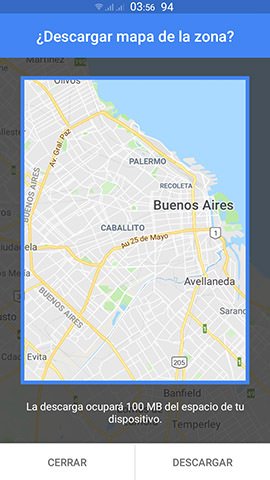
Step 1: Understanding the transport's card "SUBE"
The SUBE is a contactless smart card, with and RFID chip inside (no NWO stuff intended), used to pay for colectivos and subte. The card is a reloadable "debit" card, used only for transport.
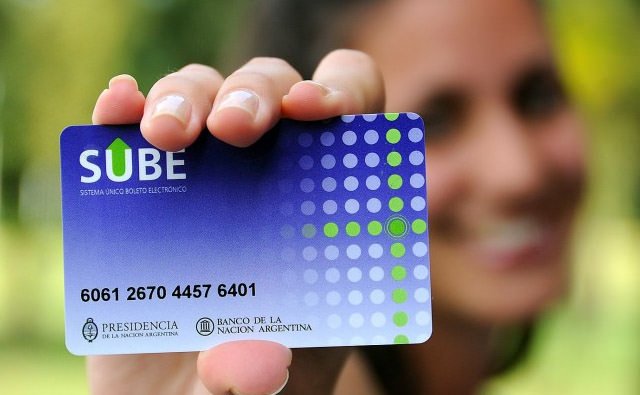
Official image promoting the SUBE card
The card cost is 25 pesos (1.39 dollars), and the transport fares are:
6.00 pesos (about USD 0.35) minimum, for travels of 1km.
6.25 pesos (about USD 0.36) rarely used.
6.50 pesos (about USD 0.37) normal, something between 2km to 6km
6.75 pesos (about USD 0.38) long travel (+6km)
7.00 pesos (about USD 0.39) used only outside the city, even longer travel
My recommendation is to get the SUBE and reload at least 100 pesos (5.55 dollars), and it will be enough for 14 travels. Argentinians use to reload something like 50-300 pesos, higher than that is rare; but it is very easy to find spots where you can reload the card if you got short of credit: almost any candy store ("Kiosko"), accept to reload your SUBE card, and you can buy candy, chocolate, bubblegum, water, a Coca-Cola, Tic-Tac and cigarretes in the same store.
Step 2: Getting the "SUBE"
In the airport (Ezeiza or Jorge Newbery) you will find a place to get your own SUBE:
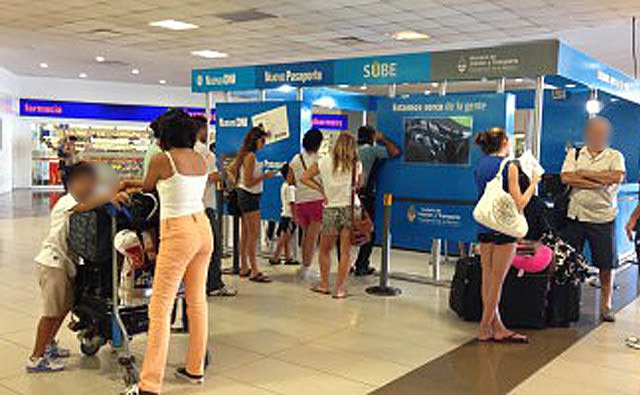
SUBE's stand on the airport
Of course, if you are getting out of the airport by taxi or remise (a private taxi), you can get your SUBE later, ask an argentinian friend to get one for you, or check the official website: https://tarjetasube.sube.gob.ar/SubeWeb/WebForms/admin/views/mapa-sube.aspx?id=1
Step 3: Getting out the airport of Buenos Aires
Let say that you arrive to the city by plane, and landed on the airport "Aeroparque Internacional Jorge Newbery", something usual if your plane is coming from Brazil, Chile or Uruguay. Get your SUBE card with enough credit, and get out of the airport by feet.
Now you are here:
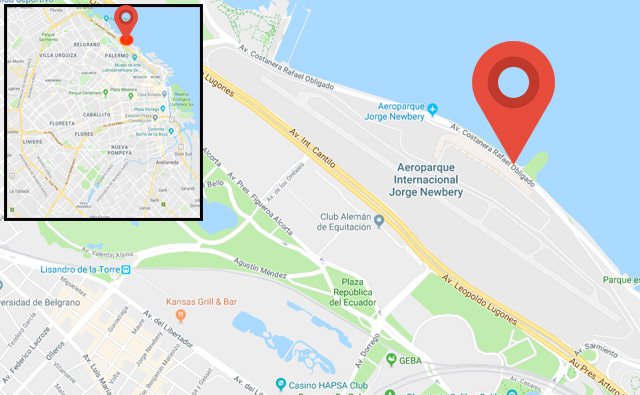
Check in the maps app the exact name and number of the street, if you walked out of the airport, you must be on "Avenida Costanera Rafael Obligado" at number "4200". The number of the street can go from 0 to any number, each block count as 100 numbers (near 100 meters).
Enter that data on the first box "A" of the website: https://mapa.buenosaires.gob.ar/
(or in the “BA Cómo Llego” app)
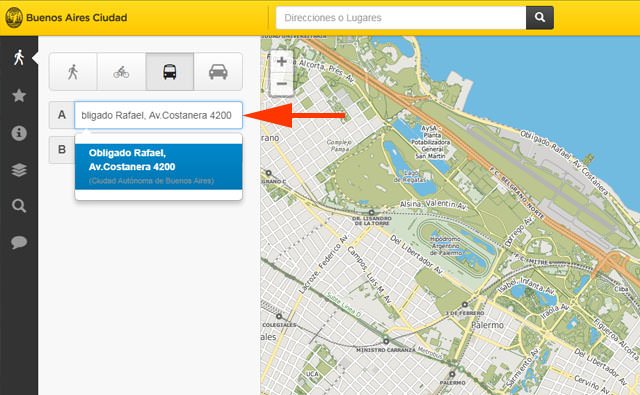
Write the name and number of the street. In this example: "Obligado Rafael, Av. Costanera 4200"
Step 4: The hotel address
Obviously, you will have the exact name and number of the street of the hotel, but in this example let say that our hotel is near the "Obelisco", the most famous historial monument of the country, located in the avenues "Corrientes" and "9 de Julio":
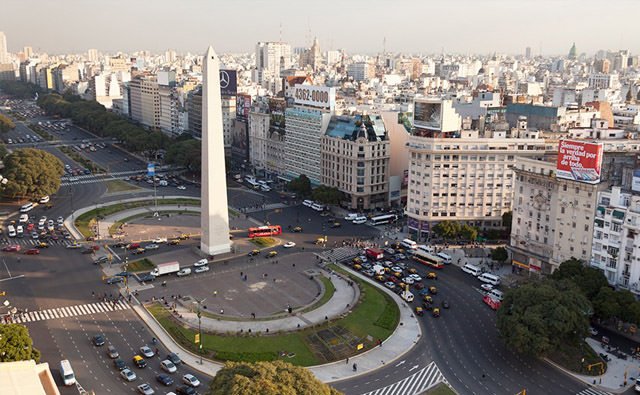
Check the map, and try to find the name of the street and the numbers. You can clearly see that the "Obelisco" is at 50 meters of "Corrientes Av." at "900". Enter that data on the second box "B" of the website
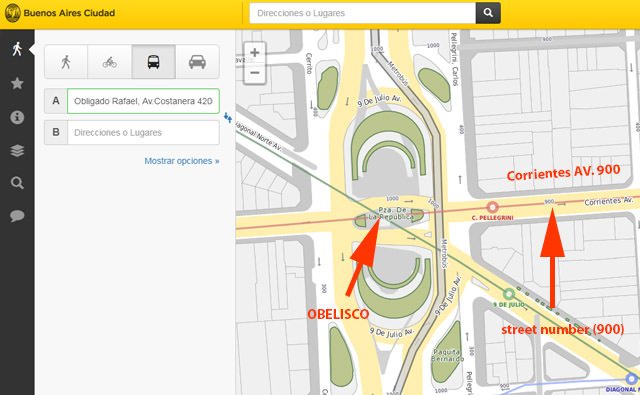
Write the name and number of the street of your hotel or the place you want to go. In this example: "Corrientes Av. 950"
Step 5: The apps tells you which colectivo you need
Ok, set the options of the application. Hide the routes given for "Subte" (the underground) and "Tren" (train)...
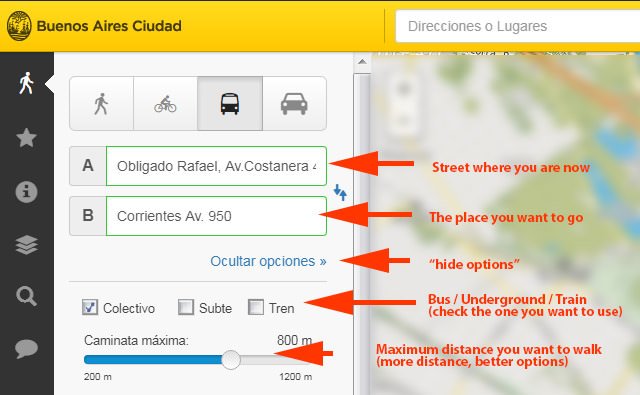
...and the app will show you the colectivo or the combination of colectivos needed to arrive to the Obelisco:
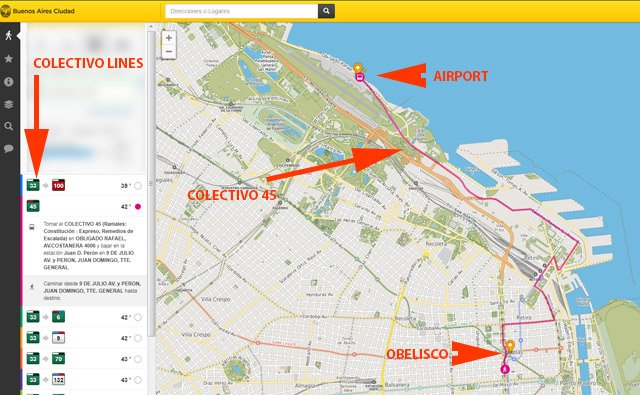
As you can see, you can combine the Colectivo 33 and the Colectivo 100; or combine the 33 with the 6; or better yet, use the colectivo number 45 (ok, sorry for the blurred image).
Just pick the one you want, and it will tell you the way, for example, the colectivo 45 is passing exactly in the same street we are (Av. Costanera 4200) and can
Step 6: Waiting for the Colectivo
Colectivos has an specific place to stop (called "parada"), you need to find this places along the way of the colectivo. Normally, you can find one each 300 meters, walk along the street, looking for the place where the Colectivo stops. It looks like this:
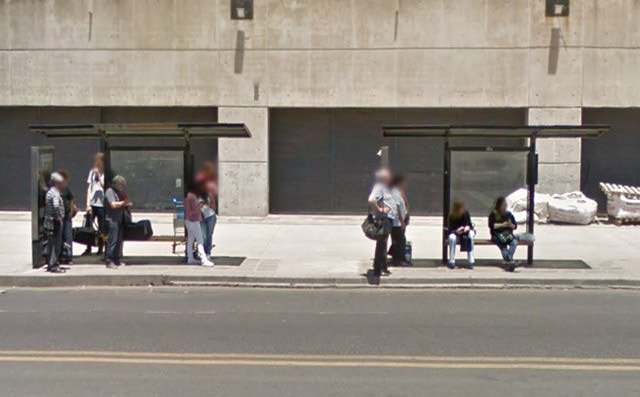
People waiting for the colectivo in the Avenida Costanera
In some places, specially on old neirboughoods or low traffic streets, the "parada" will be only marked with a small and simple sign. Example:
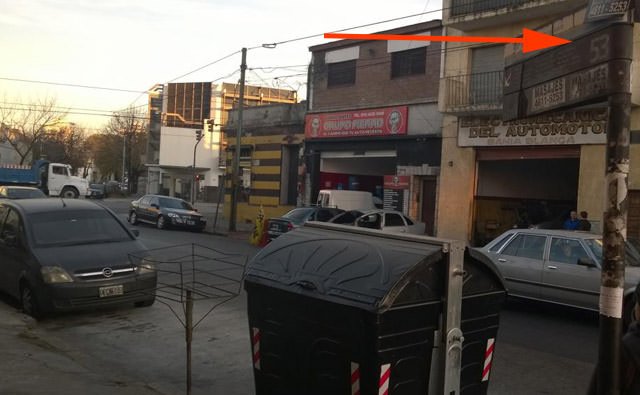
Worst case scenario
But don't worry, if the number is there, they will surely stop.
Step 7: Stopping the colectivo and paying for it
Do you see the colectivo coming? OK, give the signal! The hand signal is the same for stopping a taxi in USA, like in the beggining of "Red Hot Chili Peppers - By the Way" official video:
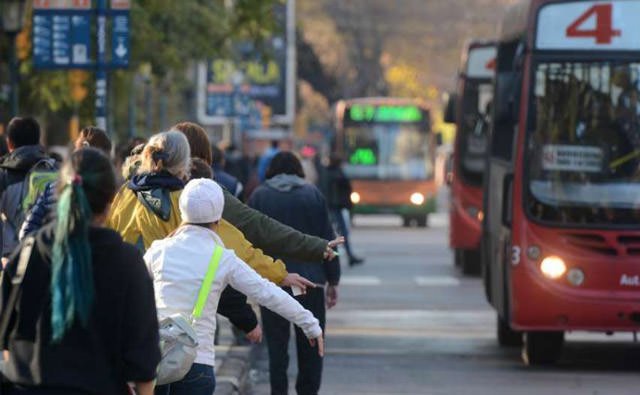
Ok, some people don't raise their hand as much...
Step 8: Jumping on board
The colectivo stops in front of you. If you are a man, don't worry about "women and children first" rule, if you are first on the line, get in the bus first. Of course, sometimes you can let men or women carrying small childrens, or elderly people go first, up to you.
Once inside, you will find the "SUBE machine" at your right, or behind the driver at your left. Check this video to get a better understanding:
Simply say to the driver the place you want to go (recommended), or the fee you will pay (not recommended). Some Colectivo lines may have alternative paths (indicated in a small colored board in front of the bus), even with the same number, so it is better to say the place you want to go, because if you are wrong, the driver will tell you "sorry, I'm not going there".
But don't worry, just say:
- Hola, hasta el Obelisco (Hello, to the Obelisk)
- Buenas, hasta el Obelisco (Good morning/afternoon/evening, to the Obelisk) (wildcard word)
- Hola, seis cincuenta ("Hello, Six, Fifty"/"Hello, 6.50")
- ¿Llega hasta el Obelisco? (Does it go to the Obelisk?)
Then, the driver will write in his keypad the fee, and you have to put your card close to the SUBE machine, as you can see in the video above, and in this image:
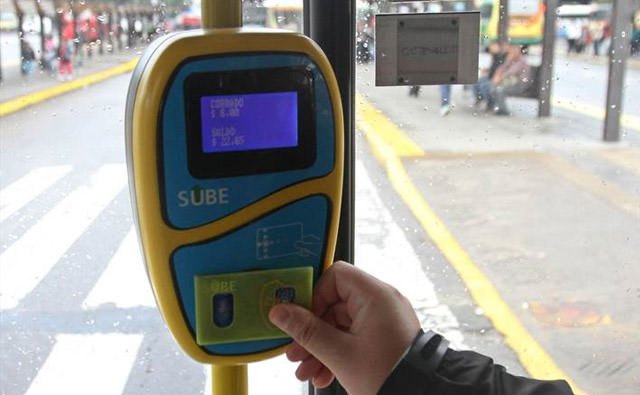
The SUBE machine may be different in each colectivo
Once you paid, say Gracias (thanks), and walk in.
Step 9: "Inside the colectivo" Etiquette
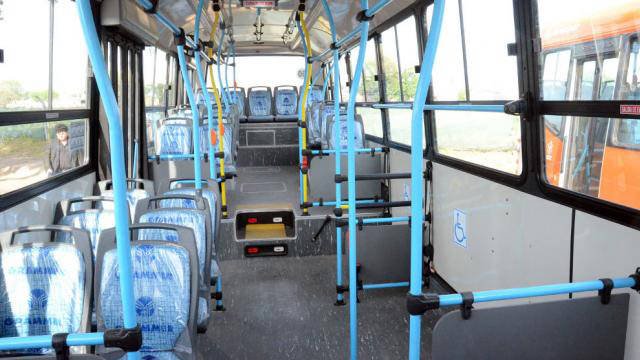
Most common design in the city, all colectivos have place for 1 or 2 wheel chairs.
A piece of cake: take a sit, and wait to arrive to the place you want to go. Use the GPS of you phone to guide yourself; if you spanish is good enough and the colectivo is not full on a peak hour, you can also ask the driver to let you know when you arrive.
Depending on the time of the day, and the line you are using, people can be reading the newspaper, sending messages with their phones, listening to music, the normal things done in a public transport of any country.
- Some people talk in the phone, something seen as not very polite; avoid making calls, but if you have to pick up a call, do it.
- At saturday night, when the buses are almost empty, it is not uncommon to see teens listening to music with the speakers on, it is not polite at all. Don't mimic this behavior, always use your headphones.
- If the colectivo is almost full, don't sit on the first row. It is reserved for people with "reduced mobility": pregnant, elderly, broken legs... You can use it, but you will have to give up the place if a person with "reduced mobility" get on board.
- Rarely, an inspector of the colectivo company will get on board and ask each passenger for their SUBE card, to verify if they really paid for the travel. It is easy to recognize them, they dress the company clothes (usually a white shirt with a logo), and have a little RFID reader on their hands. Just give them your card, he will verify it in the reader, and he will give the card back to you in 10 seconds.
Another important factor is security. I have never been robbed in a colectivo in my entire life, and I consider them very safe, specially inside the City of Buenos Aires, but you have to take the same security measures of any public place: keep an eye on your bag, wallet and phone.
The colectivo is a very quick and cheap way of moving in a city where using cars may be a headache. That is why you can find both lower class and higher class people, it is not rare to find men with expensive suits and phones in colectivos near the Obelisco or Puerto Madero neirbourghood on peak hours. Some lines go to the factories, and you will find more workers there; other lines connect universities, and you will find more students. Colectivos are used by almost everybody in the city.
Last Step: Getting out the colectivo
If you are using your GPS, you will see when you are close to the destination. Just ring the bell and the colectivo will stop in the next "parada" (maybe 200/400 after you ring it):
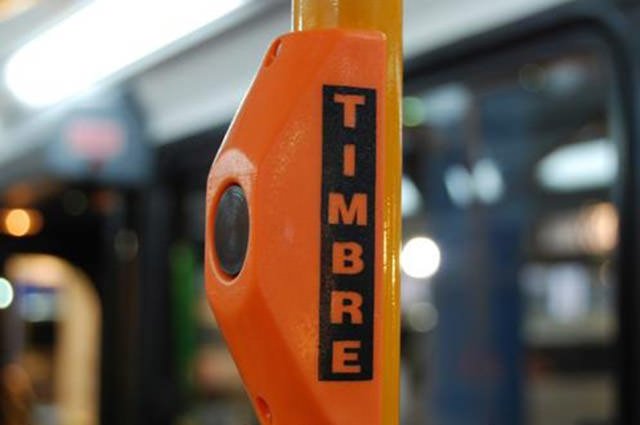
The "timbre"
That is all, it stop and opens the door.
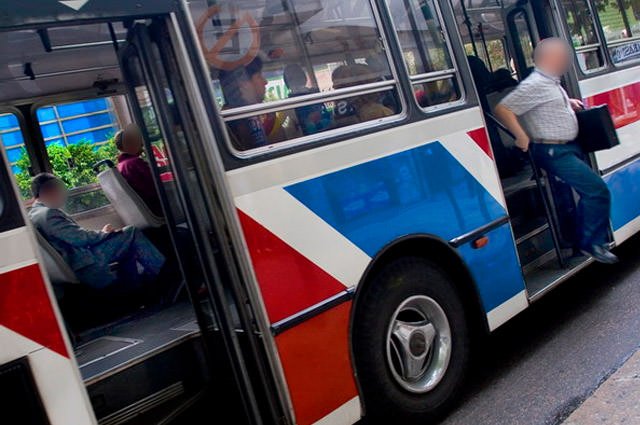
Bonus: spanish/english phrases
Note: my english is not perfect.
- Hola, ¿tiene una tarjeta SUBE? (Hello, do you have a SUBE card?)
- Buen día, ¿venden tarjetas SUBE? (Good morning, do you sell SUBE cards?)
- Buenas, ¿cargan la SUBE? (Good morning/afternoon/evening, do you reload the SUBE card?)
- Disculpe, ¿acá pasa el colectivo 50? (Excuse me, is the colectivo fifty passing here?)
- Necesito ir al Obelisco/Plaza de Mayo/Abasto Shopping (I need to go to the Obelisk/Plaza de Mayo/Abasto Shopping)
- ¿Habla inglés/francés/italiano/portugués? (Do you speak english/french/italian/portuguese?)
By the way, argentinians understand quite well portuguese and italian, even without knowing the language. And a lot of people of 40 years or less can speak a good enough english.
That is all, hope you have enjoyed. Any question, let me know.
Adrián
Congratulations @xylber! You have completed some achievement on Steemit and have been rewarded with new badge(s) :
Click on any badge to view your own Board of Honor on SteemitBoard.
For more information about SteemitBoard, click here
If you no longer want to receive notifications, reply to this comment with the word
STOP